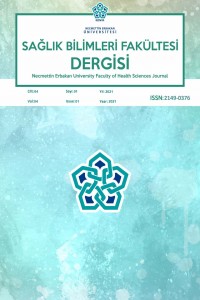Abstract
Postoperative hypothermia is common after surgery; that may affect hospital stay, wound healing, patient satisfaction; It is defined as the situation where the central body temperature drops below 36°C. Hypothermia; it can be caused by reasons leading to decreased heat production, increased heat loss or disrupted thermoregulation. It is classified in three different categories: light, medium and heavy. Maintaining normothermia in surgical patients; It is important for patient safety, patient satisfaction, obtaining positive surgical results and maintaining quality care. It is one of the important responsibilities of the surgical nurse to know the factors that increase the risk of hypothermia and preventive interventions in the surgical patient, to apply effective active and passive heating methods and to closely monitor the body temperature. Considering the problems and complications caused by hypothermia, preventing the development of hypothermia is important in ensuring the safety of the surgical patient. Surgical nurses, which have an important role in preventing hypothermia, can contribute to the creation of hypothermia prevention guides by experimental research.
References
- Referans1 Aksu, C., Kuş, A., Gürkan, Y., Solak, M., & Toker, K. (2014). Kocaeli Üniversitesi Ameliyathanesi Postoperatif Hipotermi İnsidansı Araştırması. Turkish Journal of Anesthesia Reanimation, 42(2):66- 70 Referans2 Braunstein, G. (2011). Chapter 9: The hypothalamus The pituitary (pp. 303-343). London: Elsevier. Referans3 Cooper, S. (2006). The effect of preoperative warming patients' postoperative temperatures. AORN, 83(5), 1090-1113. Referans4 Fred, C., Ford, S., Wagner, D., & Vanbrackle, L. (2012). Intraoperatively acquired pressure ulcers and perioperative normothermia: A look at relationships. AORN Journal, 96(3), 251-260. Referans5 Hart, S., Bordes, B., Hart, J., Corsino, D., & Harmon, D. (2011). Unintended perioperative hypothermia. The Ochsner Journal, 11, 259-270. Referans6 Journeaux, M. (2013). Peri-operative hypothermia: implications for practice. Nursing Standard, 27(45), 33-38. Referans7 Karaaslan, D., & Öztürk, S. (2009). Anestezi Sonrası Titreme ve Termoregulasyon. Türkiye Klinikleri Journal of Anesthesiology and Reanimation, 7(2), 98-104. Referans8 Lauronen, S. L., Kalliomäki, M. L., Aho, A. J., Kalliovalkama, J., Riikonen, J. M., Mäkinen, M. T., ... Yli‐Hankala, A. M. (2017). Thermal suit in preventing unintentional intraoperative hypothermia during general anaesthesia: a randomized controlled trial. Acta Anaesthesiologica Scandinavica, 61(9), 1133- 1141. Referans9 Lynch, S., Dıxon, J., & Leary, D. (2010). Reducing the risk of unplanned perioperative hypothermia. AORN Journal, 92, 553-562. 10. Marino M.,Masella R., Bulzomi P., Campesi I., Malorni W. ve Franconi F. (2011). Nutrition and Human Health from a Sex–Gender Perspective; Molecular Aspects of Medicine, 32, 1-70 Referans11 Pikus, E., & Hooper, V. (2010). Postoperative rewarming: Are there alternatives to warm hospital blankets? Journal of Peri Anesthesia Nursing, 25(1), 11-23. Referans12 Yüksel, S., Uğraş, G. A. (2016). Cerrahi hastasında hipotermi gelişimini önlemede hemşirenin rolü. Mersin Üniversitesi Sağlık Bilimleri Dergisi, 9(2), 113-121.
Abstract
References
- Referans1 Aksu, C., Kuş, A., Gürkan, Y., Solak, M., & Toker, K. (2014). Kocaeli Üniversitesi Ameliyathanesi Postoperatif Hipotermi İnsidansı Araştırması. Turkish Journal of Anesthesia Reanimation, 42(2):66- 70 Referans2 Braunstein, G. (2011). Chapter 9: The hypothalamus The pituitary (pp. 303-343). London: Elsevier. Referans3 Cooper, S. (2006). The effect of preoperative warming patients' postoperative temperatures. AORN, 83(5), 1090-1113. Referans4 Fred, C., Ford, S., Wagner, D., & Vanbrackle, L. (2012). Intraoperatively acquired pressure ulcers and perioperative normothermia: A look at relationships. AORN Journal, 96(3), 251-260. Referans5 Hart, S., Bordes, B., Hart, J., Corsino, D., & Harmon, D. (2011). Unintended perioperative hypothermia. The Ochsner Journal, 11, 259-270. Referans6 Journeaux, M. (2013). Peri-operative hypothermia: implications for practice. Nursing Standard, 27(45), 33-38. Referans7 Karaaslan, D., & Öztürk, S. (2009). Anestezi Sonrası Titreme ve Termoregulasyon. Türkiye Klinikleri Journal of Anesthesiology and Reanimation, 7(2), 98-104. Referans8 Lauronen, S. L., Kalliomäki, M. L., Aho, A. J., Kalliovalkama, J., Riikonen, J. M., Mäkinen, M. T., ... Yli‐Hankala, A. M. (2017). Thermal suit in preventing unintentional intraoperative hypothermia during general anaesthesia: a randomized controlled trial. Acta Anaesthesiologica Scandinavica, 61(9), 1133- 1141. Referans9 Lynch, S., Dıxon, J., & Leary, D. (2010). Reducing the risk of unplanned perioperative hypothermia. AORN Journal, 92, 553-562. 10. Marino M.,Masella R., Bulzomi P., Campesi I., Malorni W. ve Franconi F. (2011). Nutrition and Human Health from a Sex–Gender Perspective; Molecular Aspects of Medicine, 32, 1-70 Referans11 Pikus, E., & Hooper, V. (2010). Postoperative rewarming: Are there alternatives to warm hospital blankets? Journal of Peri Anesthesia Nursing, 25(1), 11-23. Referans12 Yüksel, S., Uğraş, G. A. (2016). Cerrahi hastasında hipotermi gelişimini önlemede hemşirenin rolü. Mersin Üniversitesi Sağlık Bilimleri Dergisi, 9(2), 113-121.
Details
| Primary Language | Turkish |
|---|---|
| Subjects | Health Care Administration |
| Journal Section | Review |
| Authors | |
| Publication Date | June 30, 2021 |
| Published in Issue | Year 2021 Volume: 4 Issue: 1 |


